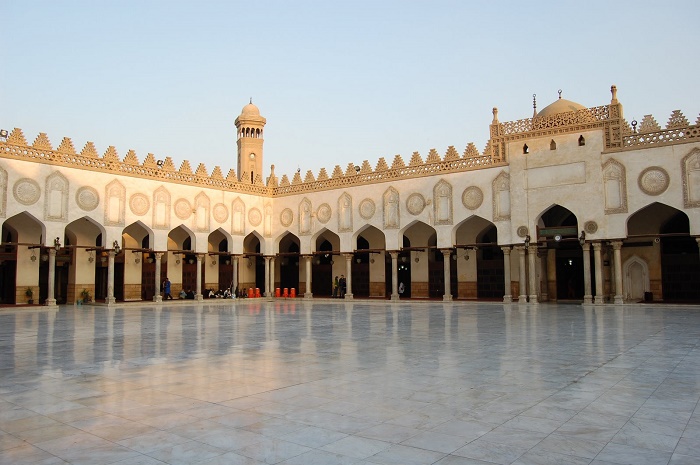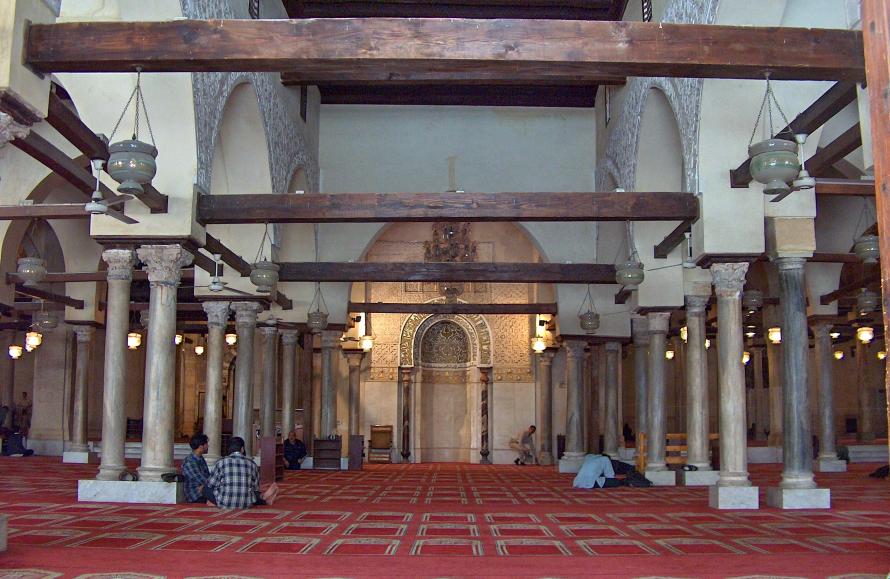Recently, Al Azhar has been in the news after the Grand Imam of Al-Azhar, Sheikh Ahmed Al-Tayeb, received Pope Francis, the head of the Roman Catholic Church, at Al-Azhar headquarters, with the Pope participating in Al-Azhar’s International Peace Conference, held on April 26.
In this article, we present a short history of the Al-Azhar mosque and its progressive transformation into one of the most influential centers of Islamic learning for more than a millennium.
Al-Azhar Mosque in Cairo, Egypt is a fundamental Islamic monument with many dimensions. Constructed by the Caliph Al-Mu’izz li-Din Allah for the newly established capital city in 970, it was the first mosque established in Cairo.
History
When Jawhar the Sicilian, commander of the troops sent by the Fatimid Caliph Al-Mu’izz to conquer Egypt, founded Cairo in 358 H / 969 CE, he built Al-Azhar originally as a mosque. The mosque was completed within two years and opened for its first prayers on 7 Ramadan 361 H / June 22, 972 CE.
Historians differ as to how the mosque got its name. Some hold that it is called as such because it was surrounded by flourishing mansions at the time when Cairo was founded. Others believe that it was named after “Fatima Al-Zahra” the daughter of Prophet Muhammad to glorify her name. This last explanation sounds the most likely, as the Fatimids named themselves after her.
During the Fatimid times (972-1171), Al-Azhar was a minor university whose objective was to spread the Shiite teachings in Egypt. Its position was thus important to the ruling Fatimid dynasty, but had little importance to the rest of the Muslim world who had its eyes focused on Baghdad as the centre of Islamic knowledge.
Through the schools of Baghdad, Muslims got to know scholars of the calibre of Abu Hamid al-Ghazali, Abu Ishaq al-Isfara’ini, Al-Juwayni and Abu-Bakr Al-Baqilani. For the majority of Muslims, Al-Azhar was not as famous as the schools of Baghdad.
In addition, the Fatimids were looked upon by the majority of Muslims as rulers belonging to a heretic sect. This view is obvious through the declaration made in Baghdad by many Muslim scholars denouncing the Fatimids. The declaration included prominent Sunni scholars like Abu Ishaq al-Isfara’ini in addition to prominent Shii scholars like al-Sharif al-Murtada. This stand regarding the Fatimids hampered Al-Azhar from taking a prominent position in the Islamic world during the time of the Fatimids.
When the Ayyubids assumed power, Al-Azhar was converted to the Sunni (mainstream) Islamic teachings. But with the establishment of the Ayyubid schools in Egypt, Al-Azhar’s position in the Islamic world became of little importance. It was considered just another school among the many schools in Egypt, Baghdad, Syria and Andalusia.

The inner courtyard at the Al-Azhar mosque
During the reign of the Mamluk sultan Baybars and at the hands of prime minister Izz al-Din Aydmer, Al-Azhar witnessed a rebirth that elevated it to become the highest ranking institution of Islamic education. Aydmer lived in a palace neighboring Al-Azhar. He proposed to Baybars a plan to renew the mosque. The sultan welcomed the idea and provided the funds necessary for refurbishing the mosque. Aydmer was aided by many Mamluk princes who offered their money for the mosque.
Subsequently, Aydmer went further and proposed performing the main Friday prayer in Al-Azhar. After he had overcome the opposition to this step, he encouraged the scholars to use the mosque as their main educational institution. The support that Aydmer gave to Al-Azhar and the influx of Muslim scholars to Egypt made the Mamluk era, Al-Azhar’s golden age.
The Islamic caliphate was looked upon as the symbol of Muslim unity in the Islamic world. After the defeat of the Mongols in Ayn Jalut, Sultan Baybars invited the Abbasid family, whose Caliphate which was destroyed earlier by the Mongols, to resume their office in Cairo. With this move, many of the Islamic scholars of the east migrated to Egypt (and in some cases to Syria) fleeing from the Mongol yoke.
This immigration of Islamic scholars to Egypt was paralleled by another influx, but from the west. Many Islamic emirates in Andalusia (Spain) were overrun by the Castillan armies between 1236 and 1261 and the famous Islamic schools in Qurtuba (Cordoba), Ishbiliyya (Seville) and Balansiyya (Valencia) were destroyed. Since the Mamluk sutlanate was the most powerful state in the Muslim world at the time, Egypt became the pole of attraction for western influx of scholars.
During the Mamluk period, most of the prominent Muslim scholars of the time taught in Al-Azhar, or at least visited the institution for a brief period of time. The great care that was given to Al-Azhar by the Mamluk princes put the mosque in a position that was unequalled by any other Cairean mosque. At the same time, Al-Azhar had a curriculum of subjects that were regularly taught in it.
Some of the famous scholars who taught in Al-Azhar in the Mamluk period include:
- Abu al-‘Abbas al-Qalqashandi
- Taqi al-Din Ahmad al-Maqrizi
- Ibn Hajjar al-‘Asqalani
- Badr al-Din al-‘Ayni
- Siraj al-Din al-Balqini
- Sharaf al-Din al-Munawi
- Abu al-Mahasin ibn-Taghribirdi
- Shams al-Din al-Sakhawi
- Jalal al-Din al-Suyuti
- Muhammad ibn Ahmad ibn Iyas
- Muhammad Taqi al-Din al-Fasi
- Abd al-Rahman ibn Khaldun
With the defeat of the Mamluks in 1517, substantial architectural projects were few until the mid-18th century; in spite of this, al-Azhar’s significance continued, and under Ottoman rule it held preeminent status among Egyptian institutions of learning.
Al-Azhar today continues to pride itself on teaching Qur’anic Sciences (‘Ulum al-Qur’an), Prophetic Traditions (Hadith), Theology (‘Ilm al-Kalam), Jurisprudence (Fiqh), Fundamentals (Usul), Arabic Grammar (Nahw), Conjugation (Sarf), Rhetoric (Balagha), Arabic Literature (Adab), History (Tarikh), Medicine (Tib), Philosophy (Falsafa) and Logic (Mantiq).
Al Azhar Bodies
Al Azhar as it is now includes:
– Al Azhar Supreme Council.
– Department of Culture and Islamic Research.
– Azhar Institutes.
– Al Azhar University.
– Azhar Library.
– Islamic Research Academy.
– Fatwa Committee.

The interior of Al Azhar mosque.
Al-Azhar schools
They are schools established with the object of preparing young students to join Al-Azhar University. They have taken a modern and organized form since 1930.
Al-Azhar University:
Al-Azhar University is a natural expansion of the great mosque of Al-Azhar. It is the most celebrated of all Islamic academic institutions and universities throughout the world. For over a thousand years, Al-Azhar has produced thousands of eminent scholars, distinguished educationalists, preserving Islamic heritage and strengthening Islamic identity.
Al-Azhar University is Egypt’s oldest degree-granting university and it is renowned as “Sunni Islam’s most prestigious university”. The university started to take up its contemporary identity in the year 1930 with the addition of many colleges. Al-Azhar, Al-Azhar University consisted of the following Faculties: the Faculty of Fundamentals of Religion and the Faculty of Shari’ah Law, the Faculty of Transactions and Management, the Islamic Faculty for Girls, the Faculty of Engineering, the Faculty of Medicine and the Faculty of Agriculture. Al-Azhar University is the largest of all the Egyptian and Arab universities.
Al-Azhar Library:
Inside Al-Azhar there were book cases in all its Riwaqs. The Europeans in the 19th century sought to loot the books. However, Sheikh Muhammad Abdou realized that and started to collect the Riwaq bookcases in Al-Azhar General Library. The Library books had been recorded in two voluminous register-books where 18564 volumes had been recorded.
The importance of Al Azhar main Library is ascribed to the fact that it houses rare Islamic
manuscripts which are not available in any other library in the world. Al Azhar main Library also houses precious Islamic artifacts and antiques including Holy Quran cases, Mamuluk and Ottoman Quran books, astronomical devices, and antique pens.
Islamic Research Academy
The Islamic Research Academy was established in 1961. The Academy had replaced the Board of Senior Ulema (scholars), which had its prestige, dignity, and reverence. It was respected by all Muslims in all parts of the world. The establishment of the Academy was based on the Law of Al-Azhar Reform, approved by the of the Egyptian People’s Council in 1961.
Fatwa Committee:
Sheikh Mustafa Al-Maraghi was the first one to think of the establishment of the Fatwa Committee in Al-Azhar in the year 1935. This Committee is an important reference and authority for all Muslims on the world level. The first structure of the Committee comprised a group of senior scholars. The Committee receives five hundred men and women on daily basis. The people’s queries and the Committee members’ responses are recorded to be used when necessary.
Sources:
- Al-Azhar University
- Al-Azhar University (Arabic)
- Al-Azhar Supreme Council for Islamic Affairs (English)
- Dar Al Ifta (English)(Al-Azhar for Islamic Fatwa)